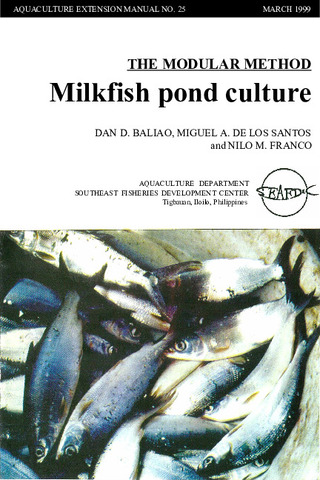Perlihatkan publikasi sederhana
Morphological aspects of the development of swimming and feeding functions in the milkfish Chanos chanos
| dc.contributor.author | Taki, Yasuhiko | |
| dc.contributor.author | Kohno, Hiroshi | |
| dc.contributor.author | Hara, Shiro | |
| dc.date.accessioned | 2013-01-11T02:33:30Z | |
| dc.date.available | 2013-01-11T02:33:30Z | |
| dc.date.issued | 1987 | |
| dc.identifier.citation | Taki, Y., Kohno, H., & Hara, S. (1987). Morphological aspects of the development of swimming and feeding functions in the milkfish Chanos chanos. Japanese Journal of Ichthyology, 34(2), 198-208. | en |
| dc.identifier.issn | 0021-5090 | |
| dc.identifier.uri | http://hdl.handle.net/10862/1283 | |
| dc.description | Contribution No. 213 of the SEAFDEC Aquaculture Department. | en |
| dc.description.abstract | Development of swimming and feeding abilities based on morphological development of larval and early juvenileChanos chanos was investigated. In larvae smaller than about 6.5 mm SL, mechanical supports of fins and branchial arches were in a primordial stage of development. Supports and rays of the vertical fins and branchial arches rapidly developed from 6.5 mm SL, and all components appeared by about 10.5 mm SL. Thereafter body depth proportion changed and the supports and rays of the paired fins and gill-rakers developed. These developmental events were nearly or totally completed by about 17 mm SL, and we concluded that the larvae transformed to juveniles at this size. By this time, the mode of swimming of the fish shifted from undulating locomotion to caudal propulsion and that of feeding from swallowing paniculate food to filtering and concentrating substrate food matters using gill-rakers and the epibranchial organ. One of the most characteristic, and well-known, phenomena in the life history ofChanos chanos is the mass occurrence in the surf zone of postlarvae of a limited size range. In view of the scheme of the development of mechanical supports of the body and fins, they may acquire a swimming ability strong enough to move against the current only upon reaching about 10.5 mm SL, and if active shoreward migration of the larvae occurs, it is only during the late period of their journey from the spawning grounds to the shore. The sudden disappearance from the surf zone of larvae larger than 15–16 mm SL is obviously related to a change in food habit. | en |
| dc.language.iso | en | en |
| dc.publisher | The Ichthyological Society of Japan | en |
| dc.subject | milkfish | en |
| dc.subject | Chanos chanos | en |
| dc.title | Morphological aspects of the development of swimming and feeding functions in the milkfish Chanos chanos | en |
| dc.type | Article | en |
| dc.identifier.doi | 10.1007/BF02912415 | |
| dc.citation.volume | 34 | |
| dc.citation.issue | 2 | |
| dc.citation.spage | 198 | |
| dc.citation.epage | 208 | |
| dc.citation.journalTitle | Japanese Journal of Ichthyology | en |
| seafdecaqd.library.callnumber | VF SJ 0212 | |
| seafdecaqd.databank.controlnumber | 1987-24 | |
| dc.subject.asfa | animal morphology | en |
| dc.subject.asfa | feeding habits | en |
| dc.subject.asfa | biological development | en |
| dc.subject.asfa | fish larvae | en |
| dc.subject.asfa | swimming | en |
| dc.subject.scientificName | Chanos chanos |
Files in this item
| Files | Size | Format | View |
|---|---|---|---|
|
There are no files associated with this item. |
|||
Publikasi ini ada di koleksi berikut
-
Journal Articles [1258]
These papers were contributed by Department staff to various national and international journals.



